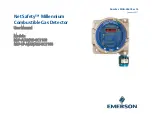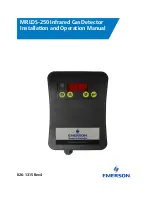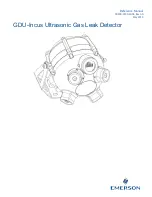
INSTALLATION AND STARTUP
OI-6000K-X-X-X-NXP-X OPS_GUIDE_REV 1.0
6
2
INSTALLATION AND START-UP
2.1
PRODUCT PLACEMENT
The installation instructions, and any other information supplied by Otis, provide only basic guidelines
relating to the properties of toxic gas and the effects of environmental conditions on the OI-6000K device.
Sensor placement should be determined in consultation with the site safety personnel, as well as those
knowledgeable of: (1) the site/facility where the equipment is being installed and (2) the potentially present
gas types and their dispersion. Otis strongly recommends that the end-user consults with the appropriate
third-party Health, Safety and Environmental (HSE) and Industrial Hygiene (IH) professionals to determine
the final quantity and placement of your gas detection devices.
The primary purpose of the OI-6000K is to provide an early warning of the accumulation of toxic gas, in order
to minimize hazards to people and property. Proper placement of the device is paramount to achieving this
goal.
The following general guidelines should be considered when determining the placement of the OI-6000K:
◼
The unit shall NOT be placed in an environment that is classified.
◼
The unit shall be placed such that the position of the sensor housing is pointing downward to the
ground.
◼
Avoid installing the unit in a location where airborne particles could cover or coat the sensor head.
◼
The unit should be placed in an area that will produce the highest gas concentration. Enclosed corners
and stopping points of moving devices are two areas susceptible to a buildup of toxic gas.
◼
In order to provide an accurate representative sample of a room, care should be taken to avoid locating
the unit near a room entrance, fresh air intake vent, or vehicle/generator exhaust point.
◼
The unit should be placed as close as physically possible to the source of the potential toxic gas leak.
◼
In consideration of possible ignition points, the unit should be placed between the potential leak
source and ignition point.
◼
Consider placing the unit in a seldom used area, such as a warehouse, storage area, or other
unfrequented location.
◼
Consider accessibility for regular calibration and other required maintenance.
◼
When monitoring a ventilated gas cylinder storage area, the unit should be placed near the air return
vent.
◼
When monitoring an outdoor or open-air area, the unit should be placed near the air intake of the
HVAC system of the building.
◼
When monitoring for the potential presence of multiple toxic gas types, the unit should be calibrated
for the least cross-sensitive toxic gas.
NOTICE
These guidelines are
ONLY
intended as a general directive for the placement of the OI-6000K. This
information should
NOT
serve as a complete list when considering all potential parameters for the proper
location of the unit. It is
STRONGLY
advised that a third party Certified Industrial Hygienist, or other
Certified Safety Professional, conduct a site survey and annotate the location and quantity of detection
devices that should be installed for
EVERY
installation of
EVERY
site.
Содержание OI-6000K NXP Series
Страница 1: ......
Страница 2: ......
Страница 67: ...APPENDICES OI 6000K X X X NXP X OPS_GUIDE_REV 1 0 62 Notes ...












































